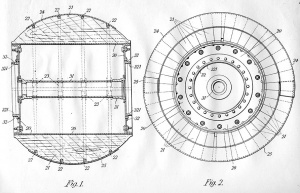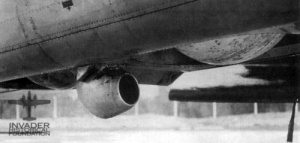Project Speedee
During the night of May 16th, 1943 the British Royal Air Force launched Operation Chastise – better known by the colloquial name “The Dambuster Raid”. The Royal Air Force sent No. 617 Squadron to attack and destroy the Mohne and Edersee damns with special high-speed bouncing bombs. The mission was a resounding success and caught the attention of the rest of the allies, including the US Army Air Force.
The special bomb used in the Dambuster Raid was developed by British Engineer Barnes Wallis. In 1942 Wallis wrote a paper called “Spherical Bomb – Surface Torpedo” describing a process by which surface ships could be attacked and sunk by any bomber that could be fitted to carry special bombs. The bombs were round, completely spherical, and spun up in the bomb bay prior to being dropped so that they hit the water with a back spin that allowed the bombs to skip across the water akin to skipping a rock across a lake. The bomb would sink under the water near the target and explode below the waterline, like a depth charge using water pressure dynamics called “bubble pulse” to rip holes in enemy ships. He also mentioned they might be suitable for use against hydro-electric dams.
In July of 1942 a British researcher named A. R. Collins carried out a test of Wallis’ hypothesis by destroying an extra dam in Wales by planting a mine underwater beside the dam. When the dam was destroyed in a manner described as “spectacularly successful” the British government moved ahead with testing.
Wallis and Collins assembled a team of researchers and engineers at Road Research Laboratory and set to work creating prototype bombs and modifying a few Vickers Wellington to carry them. Two different versions of the bomb were created. The smaller, spherical version intended to be used against ships was developed under the name “Project Highball”, while a larger cylindrical version was developed under the codename “Project Upkeep”.
Unlike the Project Upkeep bombs that were carried on the Wellington for testing and then on Lancasters during the actual Dambuster Raid, the smaller Project Highball bombs were carried on a modified DeHaviland Mosquito Mk. IVb, with a cruising speed of 200mph and a top speed of 400mph.
The original testing of Project Highball on May 9th and 19th, 1943, was hampered with problems. The original tests were carried out on Loch Striven against an old French Battleship in mothball, the Courbet. The range finding buoys were misplaced, the prototypes had several construction errors which caused them to bounce off-course, there were problems with the bombs release causing them to go too hard and too fast against the target, and some of the planes had problems with the bomb jigs, causing them to either not release at all, or to simply fall off prematurely.
Despite these setbacks, the RAF formed No. 618 Squadron on 1 Apr 1943 with the specific intent of sinking the German Battleship Tirpitz with these bouncing bombs in an operation codenamed Operation Servant. The pilots trained for this mission and the engineering crews worked on resolving the problem. By May of 1944 the bombs were ready for testing again, but this time the target was the mothballed battleship HMS Malaya. The bombs worked and punched two holes into the side of the ship.

Despite the success of the test, the Highball bombs were never used operationally by the RAF. The intended target, Tirpitz, was sunk by conventional bombing and all of the other targets had either already been destroyed or surrendered. Despite this, the US Army Air Force was still very interested in this system.
In January, 1945 a single Douglas A-26 Invader was modified by the Vickers experimental facility at Foxwarren, Surrey. The British RAF division called the Aeroplane & Armament Experimental Establishment (A&AEE) was given two A-26s by the US Army Air Force in 1944 for testing and evaluation because the RAF had expressed interest in purchasing a number of the planes. Of these two planes, one of them was destroyed during a test flight in Sep 1944, but the other was outfitted by the team at Vickers. This plane was RAF serial number KL690 (USAF Serial 43-22479). The team at the Vickers facility managed to convert the RAF A-26 to carry a pair of Highball bombs by using parts from a Mosquito conversion. The bombs were almost completely encased in the bomb bay. They flew some test flights with the system and then pulled the whole conversion components back out of the plane and shipped it as a complete kit, along with 25 inert Highball bombs, to Wright AFB, Ohio.
The USAAF tested this new system out under the codename “Project Speedee”. A single plane, serial number 43-22644, was converted using the RAF kit. This plane was formally assigned the 611th Base Unit at Wright Field, OH. The modified plane was then flown to Eglin AFB, FL under the orders of AAF board Project No. F 4480, "Program for Test of Capabilities, Suitability, Tactics & Techniques, & Comparisons of Speedee".
The personnel at Eglin met with one of the researchers from Road Research Lab who gave them the rundown of specifics on the bomb. The British planes were doing drops from between 40’ to 50’ above the water and a speed of 365 mph to ensure good distance and bounce. The bombs were tested in the nearby Choctawhatchee Bay at Water Range 60. The British researcher stayed for the first day and observed the tests to ensure that everything went smoothly, which they did. The plane’s pilot, 1LT Bryce L. Anderson, and the other 2 members of the crew were debriefed.
On Saturday, the 28th of April, 1945, 1LT Anderson and his crew took off from Eglin for additional tests. For some reason Anderson’s plane was flying at an altitude of only 10 feet above the water. It’s not clear if he was instructed by the test supervisors to try the bomb at that height or if he chose that height himself, but the results were disastrous.
A camera recording the tests from the shore caught the entire event. 1LT Anderson comes in fast at an altitude of just over 10 feet. By comparison, look at how high the RAF Mosquito pilots were when they dropped the bombs…
The bomb from Anderson’s plane released without incident and exactly 1 second later, the bomb struck the surface of the water.
1 second after that, the 950 lb bomb bounced up directly into the aft section of the plane, just behind the gunner’s compartment, completely shredding the entire tail assembly and tearing it from the plane.
The sudden absence of the tail drastically changed the plane's center of gravity and caused the plane to become very nose-heavy and it pitched forward.
Without any of the necessary control surfaces still on the plane, there was nothing that could be done to save the plane from its fate.
Three seconds after the bomb release occurred, the plane slammed into the water at more than 350 mph, killing all three crew aboard instantly. After the loss of the only Speedee modified prototype and the three crewmen aboard the plane, the American interest in the Highball skipping bombs waned and no further tests were ordered. The project was quietly closed with mixed results. The bombs could work, but were ultimately deemed too dangerous.








